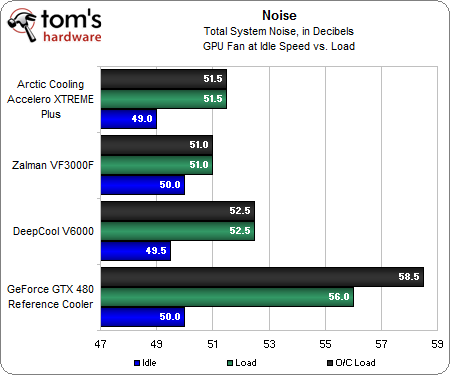Three Aftermarket Graphics Coolers On GeForce GTX 480
Today we're testing three of the largest graphics card coolers available: Arctic Cooling's Accelero XTREME Plus, DeepCool's V6000, and Zalman's VF3000F. Can these products bring performance to the table commensurate with their large triple-slot size?
Benchmark Results: Overclocking
The GeForce GTX 480 we’re testing has a reference core clock rate of 700 MHz. We’ll see how far we can take it at stock voltages when these aftermarket coolers are employed:
The reference cooler can handle 850 MHz, but DeepCool’s V6000 can only handle 840 MHz. Why? Because almost all of the VRM heatsinks fell off under load, and cool VRMs make for better overclocking ability. Despite its lower core temperature, the V6000 suffers here.
Once again, we’ll mention that DeepCool acknowledges the thermal tape problem suffered by our test sample and claims that the mass production model is fixed. If this is the case, the DeepCool V6000 will very likely achieve better results than the reference cooler. Unfortunately, without a solution in-hand at press time, we cannot corroborate DeepCool's claims.
Both the Zalman and Arctic Cooling models reach identical levels here, which is no surprise since the core temperatures they achieve are so close.
The overclock doesn’t change much as far as noise or temperatures are concerned when it comes to the aftermarket coolers, but the reference cooler certainly does get louder when pushed.
Get Tom's Hardware's best news and in-depth reviews, straight to your inbox.
Current page: Benchmark Results: Overclocking
Prev Page Benchmark Results: Temperature And Noise Next Page Conclusion: When It Comes To GPU Cooling, Bigger Is BetterDon Woligroski was a former senior hardware editor for Tom's Hardware. He has covered a wide range of PC hardware topics, including CPUs, GPUs, system building, and emerging technologies.
-
AMW1011 Wow, I can't believe the Accelero and the Zalman were basically neck and neck, with no tangible victory in cooling. I always thought the Accelero would be better, but Zalman actually pulled this one off.Reply
However, what would be AMAZING, is to have a follow-up to see which of these two solutions work best in SLI, assuming EITHER work well in SLI. I think that is the big question, especially since we never expected bad temps.
Also can you please add the voltages used for each overclock? It might give people, especially stock GTX 480 owners, a better idea of what these can handle, since cards will always vary when overclocking.
Holy ***, stock voltages! That is crazy! Please post up your VID (stock voltage) for us. Either you have a golden GTX 480, or the VID is a lot higher than it needs to be, which is pretty common.
Great article, I love to see these kind of side articles/reviews, and it was well done. -
Nerdbox87 Given that this entire article is based on cooling you really should have included all GPU temps - as vram / vrm cooling may be the difference between the Accelero and the Zalman (as I know my Accelero Twin Turbo on a 5850 struggled with vram temps in Furmark)Reply
On this my guess would be the Zalman would smash it -
joytech22 How was the 480 at just under 60C when my 470's are always idling at 86C in a Antec twelve hundred..?Reply
I mean sure this case isn't the best cooling case but there's never really much hot air in the case and with a sidepanel fan blowing on the two cards i just cant see how.
Unless.. you guy's test in a cool room at about 15-20C or the fan speeds are maxed 100% of the time. -
dvijaydev46 Oh, Zalman's cooler looks weaker than Accelero but the later actually outperforms a bit. That's amazing.Reply -
Th-z Don, what is your view on how to apply thermal paste. There are numbers of ways people talk about: a pea in the middle, several peas, line in the middle, several lines, and old school spread method. You use spread method when you apply the RAM/VRM sink on Zalman, I presume you use the same method on other parts, too. Maybe Tom can do a comparison test on different ways of applying thermal paste.Reply -
compton These look good and would help me out quite a bit with a 465/470, but I wish I could get them in a design that would help maintain the existing footprint. My GF100 doesn't run quite as hot as some reference card designs, but that sure as hell doesn't mean that I'm happy with the leaf blower lurking in my case. Maybe I find a way to make the Zalman work.Reply -
avatar_raq I think the Zalman one wins here. It performs slightly better, costs slightly less, weighs less and is shorter than the Arctic cooler. As for noise they're trading blows. Being shorter, the VF3000 does not increase the length of the GTX 480, unlike the accelero which may theoretically cause incompatibility with some cases. Being lighter, it strains the PCB much less. The fact it performed so close to the Arctic cooler with only 2 fans surprised me.Reply


